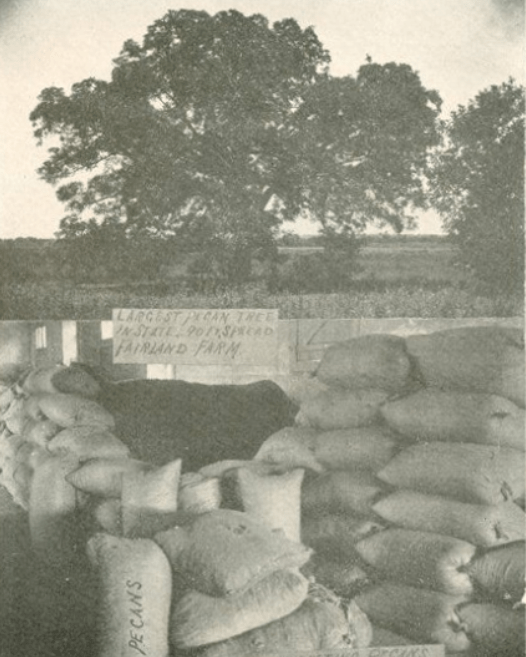
I’m partial to pecan trees. In part this is because of their cautious nature–they are philosophers. In the early spring, when the rest of the tree world is frolicking in the warm sun, the pecan folds its arms and waits. Like a wizened old man, aloof from the childish antics around him, he’s not going to be fooled into venturing his leaves out too soon. He’ll think about it first. Through a hot summer, these wary trees will save themselves by aborting their nuts and shedding leaves.
It’s the heat and drought causing the leaves to fall off of the pecan trees in our yard. Pecan trees are pretty tough, but so is this summer. I got to thinking about some of the big old pecan trees around here and how many summers like this one they’ve weathered to get where they are, and how they’ve helped us grow along the way. Brown County has entwined history with these trees. Records show that in 1885, according to the Brownwood Bulletin, a man named Frank Swindon “planted 400 acres of pecan trees along the banks of the Pecan Bayou.” This is the first mention of anyone cultivating pecan trees here that I could find. By 1910, Brown County was cultivating 46,400 pecan trees. The county was among the top Texas counties in pecan production in 1919, hauling in an estimated 58,000 pounds of pecans.
While San Saba is the state’s largest producer of pecans, Brown County produces a good crop too, and it also has a bit of history with research projects into the growth and development of pecan trees. The US Department of Agriculture constructed a Pecan Insect Laboratory in Brownwood in 1920 to investigate growing techniques and develop protection plans for pecan orchards in the US. In 1931, the US Pecan Research laboratory was established in Brownwood. A project of the University of Texas, the facility was designed to record and monitor pecan production techniques and innovations such as spacing of trees, nut varieties and soil content for growing the best nuts.
A place called Fairland Farm, which was a dairy just outside of Brownwood, claimed to have the largest pecan tree in the state at one time. It’s a bit of a contest across Texas even today. The largest tree winners often like to display their giants, and they make great tourist attractions. Parker County currently has the biggest tree, according to Texas A&M, at 91 feet tall and 21.5 feet around, and Weatherford has one that is also a massive specimen.
Pecan production took a backseat to peaches and cotton in Brown County, but it’s on the upswing again with the addition of Pecan Grove Farm near Lake Brownwood. The farm has over 1,000 acres in cultivation, and driving by it is something to see. There are miles of pecan trees out there. The farm does not sell nuts directly to the public, but they do sell pecan trees if you’re looking to get in the business. I wouldn’t dare. I’m just trying to keep our two alive at this point, reading up on how to water them and make sure they don’t have any pests taking advantage of their drought-weakened selves.
According to the state of Texas, fossilized evidences shows that pecan trees have grown in the state since prehistoric times, and the word peccan in the Algonquian dialect, means“hard-shelled nut”. It’s safe to say that for thousands of years, the pecan tree has sustained life in central Texas.
I love the old trees. They all have long stories we will never know. There are still a lot of giant old pecan trees along the banks of the bayou. Fabis Park has some truly stunning trees. I don’t know how old they are, but well over 100 years for sure. Likely some of them are native, or were among the first trees planted, maybe even started by Frank Swindon himself! If you take the walking trail at the end of Riverside Park, you can also find some enormous specimens. Pecans like to grow around the river bottoms, and in a good spot they can really take hold, easily reaching 100 feet tall. Perhaps somewhere in the brush there’s still a grandfather tree that can put us back on the competitive map for size. It won’t be mine though, I’m just hoping the ones here make it through the long, dry summer alive.
***
Diane Adams is a local journalist whose columns appear Thursdays on BrownwoodNews.com
